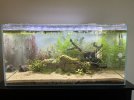About 1.5 weeks ago, I bought a trio of apistogramma agassizii fire red (one male, 2 females). I had wanted a pair but the online store I got them from was only selling them in trios. When they arrived, one female was already slightly larger than the other. I have them in a pretty heavily planted 30 gallon tank with 5 corydoras, 4 otocinclus, and a few endlers.
The larger female and the male paired up quite quickly and actually laid eggs a few days ago (they ate them though, from what I can tell). However, the pair quickly began chasing and bullying the smaller female as soon as they paired up. Today I noticed she has become quite pale and I think she is very stressed. I contacted my local fish store and they'll buy her from me, but I'm very sad to lose her since she seemed to be the most curious and interactive of the trio.
Is there anything I can do to minimize aggression before re-homing the smaller female? I'm also wondering if I could give up the larger female instead and maybe have the male pair up with the smaller one. Any thoughts on what I can do here? I don't want to rescape my tank if possible because it's dirt capped with sand.
The larger female and the male paired up quite quickly and actually laid eggs a few days ago (they ate them though, from what I can tell). However, the pair quickly began chasing and bullying the smaller female as soon as they paired up. Today I noticed she has become quite pale and I think she is very stressed. I contacted my local fish store and they'll buy her from me, but I'm very sad to lose her since she seemed to be the most curious and interactive of the trio.
Is there anything I can do to minimize aggression before re-homing the smaller female? I'm also wondering if I could give up the larger female instead and maybe have the male pair up with the smaller one. Any thoughts on what I can do here? I don't want to rescape my tank if possible because it's dirt capped with sand.
